1995 Oldsmobile Cutlass Supreme oil
[x] Cancel search: oilPage 7 of 340

Vehicle Symbols
These are some of the symbols you may find on your vehicle.
3.
For example,
these sym%ols
are used on an
original battery:
POSSIBLE A
CAUTION
INJURY
PROTECT EYES BY
SHIELDING
CAUSTIC
BURNS
SPARKS
OR
FLAMES
SPARK
OR
FLAME ,I#$,
COULD
EXPLODE
BATTERY
These symbols are important
for you and
your passengers
whenever your vehicle is
driven:
POWER
WINDOW n-
These symbols
have to do with your lights:
SIGNALS e
TURN
pA;:z
pf
WARNING A
HAZARD
FLASHER
HIGH
LAMPSoR BEAM = =o
FOG LAMPS 3 0 '
These symbols
are on some
of
your controls:
WINDSHIELD
WIPER
'r' -4
WINDSHIELD 6$
WASHER I
WINDSHIELD
DEFROSTER
REAR
WINDOW
DEFOGGER
VENTILATING
b
. FAN
These symbols are used
on
warning and
indicator lights:
CHARGING ,I-1
BAllERY
SYSTEM
BRAKE
(a)
RADIATOR COOLANT
a
ENGINE OIL
PRESSURE Wh
. TEMP OIL
ANTI-LOCK
(@)
BRAKE
Here are some
other symbols
you may see:
FUSE
RADIO
k
VOLUME a
CONDITIONING AIR 43
LIGHTER k
SPEAKER
b
V
Page 112 of 340
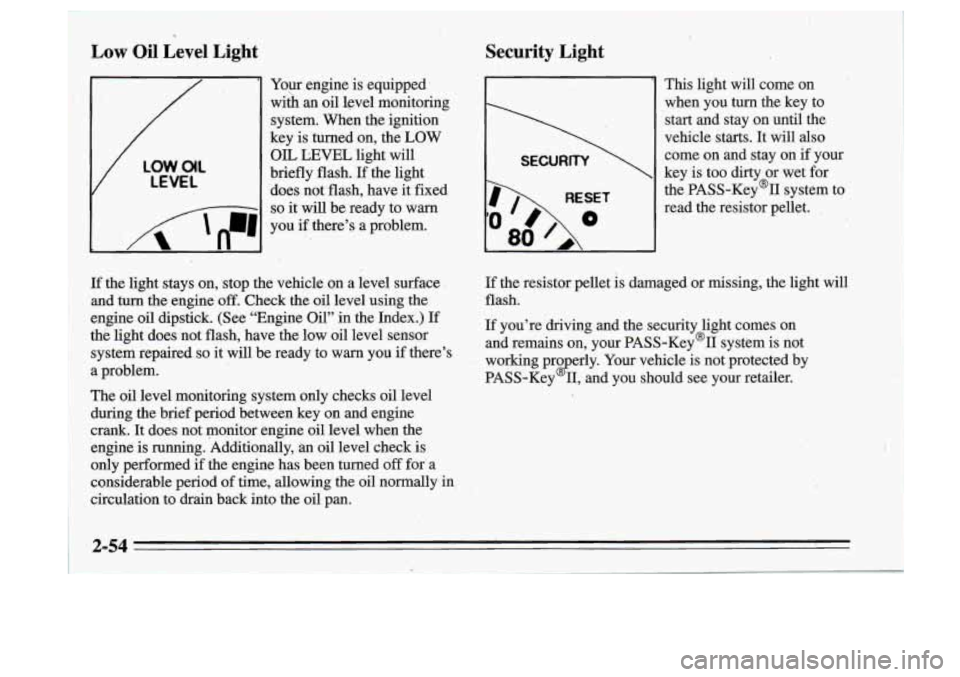
.(I
Low Oil Level Light
Your engine is equipped’
wiih
an oil level monitoring
system. When the ignition
key is turned on, the
LOW
V
LOW.O(L
LEVEL
OIL LEVEL light will
briefly flash.
If the light
‘does not flash, have it fixed
I 8 - -1 so it will be ready to warn
I n
I ‘A ‘n-1 , .
you if there’s a problem.
- ..
Security Light
I
RESET
80
This light will come on
when you
turn the key to
start and stay on until the
vehicle starts.
It will also
come on and stay on if your
key is too dirty or wet for
the PASS-Key% system to
read the resistor pellet.
,
If the light stays on,, stop the vehicle on a level surface
and turn the engine
off. Check the oil level using the
engine oil dipstick. (See “Engine Oil” in the Index.) If
thti light does not flash, have
the low oil level sensor
system repaired
so it will be ready to warn you if there’s
a problem.
The
oil level monitoring system only checks oil level
during the brief period between key on and engine
crank. It does not monitor engine oil level when the
engine is running. Additionally,
an oil level check.is
only performed if the engine has been turned
off for- a
considerable period
of time, allowing the oil normally in
circulation to drkn back into the oil pan.
If the resistor pellet is damaged or missing, the light will
flash.
If you’re driving and the security light comes on
and remains on, your PASS-Key’II system is not
working pro erly. Your vehicle is not protected by
PASS-Key
2 11, and you should see your retailer.
2-54
t
Page 113 of 340

Head-Up ,Display (Option)
If you have the Head-Up Display (HUD), you can see
the speedometer reading, in English or metric units,
displayed “through” the windshield.
The HUD
also shows these lights when they are lit on
the instrument panel:
0 Turn Signal Indicators
0 High-Beam Indicator Symbol
Low Fuel Symbol
Oil Warning Symbol
0 Coolant Temperature.Symbo1
Charging System Symbol
I
When you sit straight in your seat, the HUD image will
appear slightly to the right.
When the ignition key is turned to RUN, all possible
HUD images will come on. Then the Head-Up Display
will operate normally.
NOTICE: 1.
Although the HXJD image appears to be near the
front of the vehicle, do not use it as a parking aid. The
.HUD was not designed for that purpose. If
you try to use it that way,-such as in,a parking
lot, you may misjudge distance and run into
something.
J
2-55
. ..
Page 135 of 340
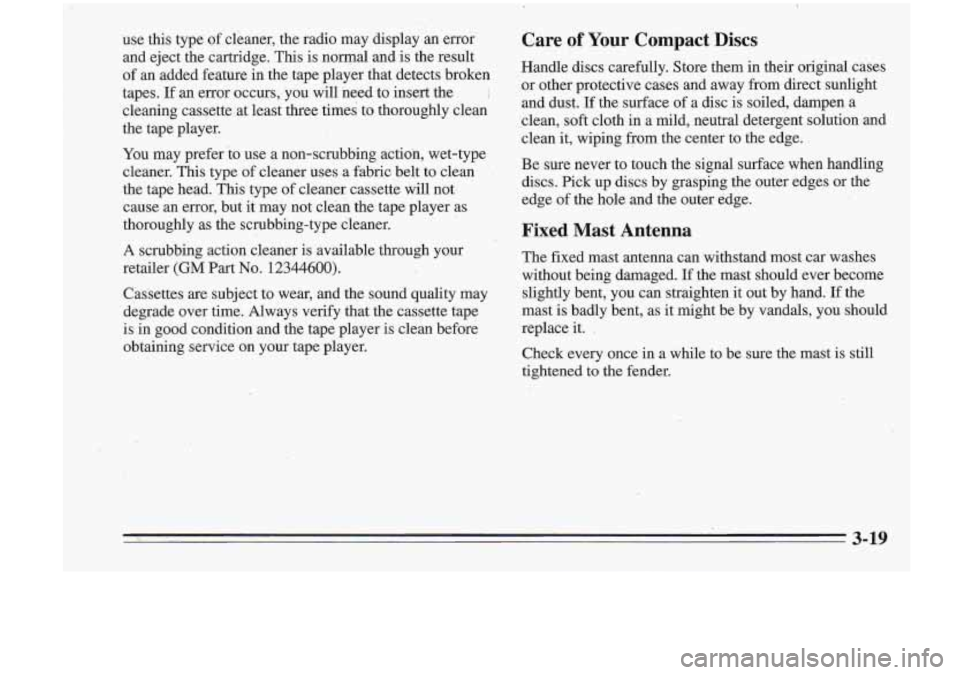
use this type of cleaner, the radio may display an error'
and eject the cartridge.
This is nongal and is the result
of an added feature in the tape player that detects broken
tapes.
If an error occurs, you will need to insert the ;
cleaning cassette at least three times to thoroughly clean
the tape player.
You may prefer to use a non-scrubbing action, wet-type
cleaner.
This type of cleaner uses a fabrio belt to clean
the tape head. This type of cleaner cassette will not-
cause an error, but it may not ckan the tape player as
thoroughly as the scrubbing-type cleaner.
n scrubbing action cleaner is available through your
retailer
(GM Part No. 12344600).
Cassettes are subject 'to wear, and the sound quality may
degrade over time. Always verify that the cassette tape
is
in good condition and the tape player is clean before
obtaining service on your tape player.
Care of Your Compact Discs
Handle discs carefully. Store them in th,eir original cases
or other protective cases and away from direct sunlight
and dust.
If the surface of a disc is soiled, dampen a
clean, soft cloth ,in
a mild, neutral detergent solution and
clean it, wiping from the center to the edge.
Be sure never to touch the signal surface when handling
discs. Pick up discs by grasping the outer edges
or the
edge of the hole and the outer edge.
Fixed Mast Antenna
The fixed mast antenna can withstand most car washes
without being damaged.
If the mast should ever become
slightly bent, you can straighten it out by hand. If the
mast
is badly bent, as it might be by van.dals, you should
replace it.
I
Check every once in a while to be sure the mast is still
tightened to the fender.
3-19
Page 157 of 340
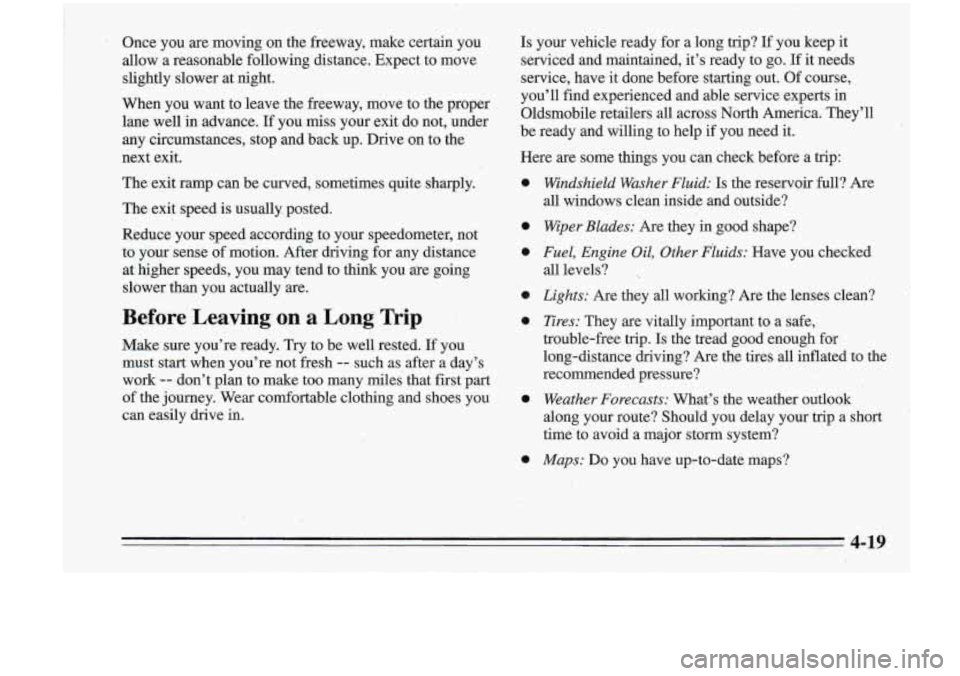
3 Once you are m,oving on the freeway, make certain you
allow a reasonable following distance. Expect to move
slightly slower at night.
When you want to leave the freeway, move to the proper
lane well in advance.
If you-miss your exit do not, under
any circumstances, stop and back up. Drive on to the
next exit.
The exit ramp can be curved, sometimes quite sharply.
The exit speed is usually. posted.
Reduce your speed according to your speedometer, not
to your sense of motion. After driving for any distance
at higher speeds, you may tend to think you are going
slower’than you actually are.
Before Leaving on a Long- Trip
Make sure you’re ready. Try to be well rested. If you
must
start when you’re not fresh -- such as after a day’s
work
.-- don’t plan to make too many miles that first part
of the journey. Wear comfortable clothing and shoes you
can easily drive in. Is your vehicle ready
for a long trip? If you keep it
serviced and maintained, it’s ready to go.
If it needs
service, have it done before starting out. Of course,
you’ll find experienced and able service experts in
Oldsmobile retailers all across North America. They’ll
be ready and willing to help
if you need it.
Here are some things you can check before a trip:
0
0
0
0
0
0
0
,Windshield Washer Fluid: Is the reservoir full? Are
all windows clean inside and outside?
Wiper Blades: Are they in good shape?
Fuel, Engine Oil, Other FZuids: Have you checked
all levels?
,
Lights: Are .they all working? Are the lenses clean?
Tires: They are vitally important to a safe,
trouble-free trip. Is the tread gaod enough for
long-distance driving? Are the tires all inflated to the
recommended pressure?
Weather Forecasts: What’s the weather outlook
along your route? Should you delay your trip a short
time‘to avoid a major
storm system?
Maps: Do you have up-to-date maps?
,
Page 172 of 340
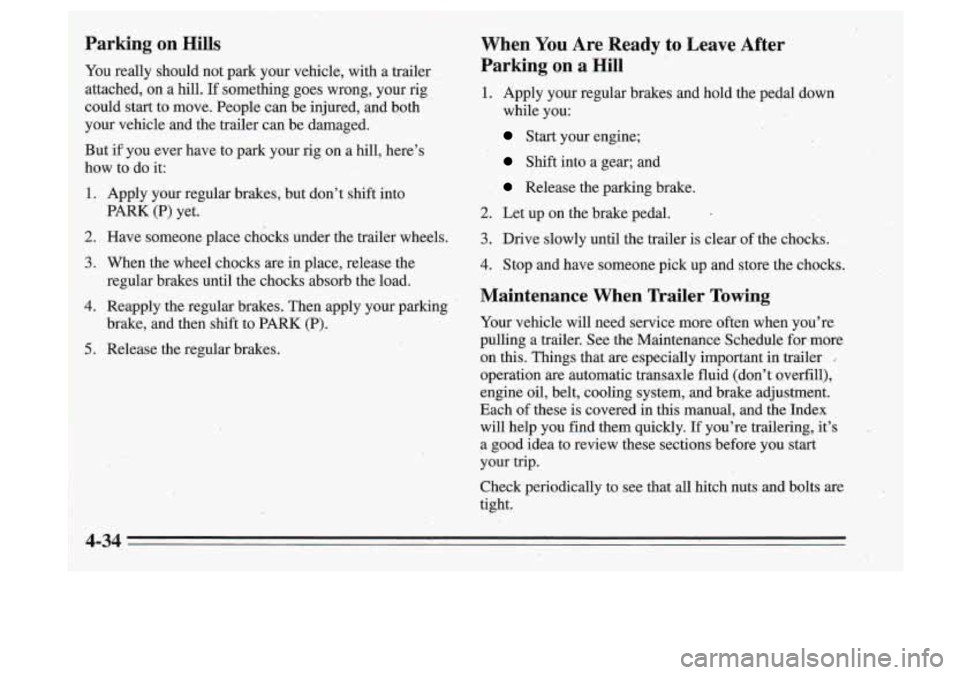
Parking on Hills
You really should not park your vehicle, with a trailer
attached,
on a hill. If something goes wrong, your rig
could start to move. People can be injured, and
both^
your vehicle and the trailer can be darnaged.
But if you ever have to park your rig on a hill, here’s
how to do it:
.I. Apply your regular brakes, but don’t shift into
.. !PARK (P) yet.
2. ‘Have someone place chocks under the trailer wheels.
3. When the wheel chocks are in place, release the
regular brakes until the chocks absorb the load.
4. Reapply the regular brakes. Then apply your parking
brake, and then shift to PARK
(P).
When You Are Ready to Leave After
Parking o,n a
Hill
1. Apply your regular brakes and hold the pedal down
8’. .
while you:
Start your engine;
Shift into a gear; and
Release the parking brake.
2. Let up on the brake pedal.
3. Drive slowly until the trailer is dear of the chocks.
4. Stop and have someone pick up and store the chocks.
Maintenance When Trailer Towing
Your vehicle will need service more often when you’re
pulling a trailer. See the Maintenance Schedule for,more
.on this. Things that are especially important in trailer
operation are automatic transaxle fluid (don’t oyerfill),
engine oil, belt, cooling system, .and brake adjustment.
Each of these
is covered in this manual, and the Index
will help you find them quickly. If you’re trailering, it’s
a good idea
to review these sections before you start
your trip.
Check periodically to see that all hitch nuts and bolts are
tight.
4-34,
Page 187 of 340
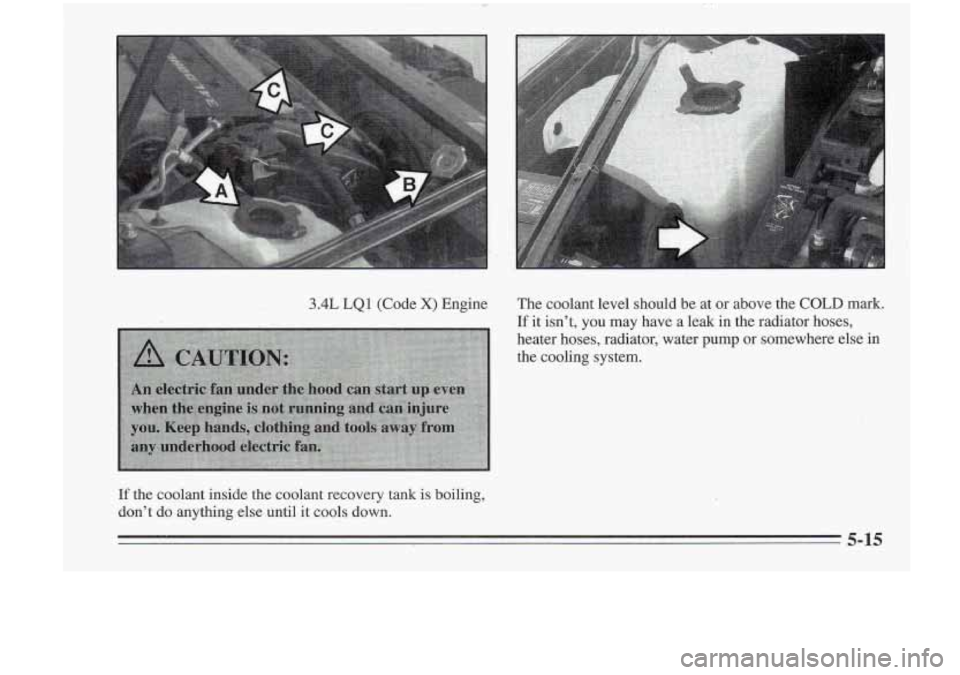
3.4L LO1 (Code X) Engine Y The coolant level should be at or above the COLD mark.
If it isn’t, you may have a leak in the radiator hoses,
heater hoses, radiator, water
pump or somewhere else in
the
cooling system.
If the coolant inside the coolant recovery tank is boiling,
don’t do anything else (until it
cools down.
5-15
Page 208 of 340
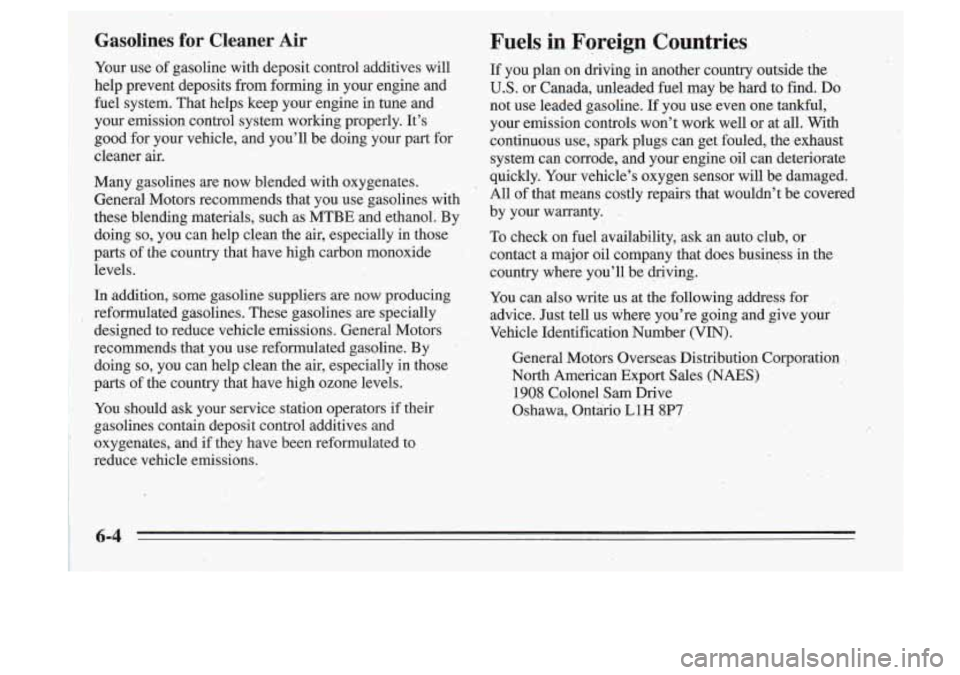
I
Gasolines for Cleaner Air
Your use of gasoline with deposit control additives will
help prevent deposits from forming in your engine and
fuel system. That helps keep your engine in tune and
your emission control system working properly. It’s
good for your vehicle, and you’ll be doing your part for
cleaner air.
Many gasolines are now blended with oxygenates. General Motors recommends that you use gasolines with
these blending materials, such as MTBE and ethanol. By
doing
so, you can help clean the air, especially in those
parts of the country that have high carbon monoxide levels.
In addition, some gasoline suppliers are now producing
reformulated gasolines. These gasolines are specially
designed to reduce vehicle emissions. General Motors
recommends that you use reformulated gasoline. By doing
so, you can help clean the air, especially in those
parts of the country that have high ozone levels.
You should ask your service station operators if their
gasolines contain deposit control additives and
oxygenates, and
if they have been reformulated to
reduce vehicle emissions.
Fuels in Foreign Countries
If you plan on driving in another country outside the
U.S. or Canada, unleaded fuel may be hard to find. Do
not use leaded gasoline. If you use even one tankful,
your emission controls won’t work well or at all. With
continuous use, spark plugs can get fouled, the exhaust
system can corrode, and your engine oil can deteriorate
quickly. Your vehicle’s oxygen sensor will be damaged.
All of that means costly repairs that wouldn’t be covered
by your warranty.
To check on fuel availability, ask an auto club, or
contact a major oil company that does business in the
country where you’ll be driving.
You can also write us at the following address for
advice. Just tell
us where you’re going and give your
Vehicle Identification Number (VIN).
General Motors Overseas Distribution Corporation
North American Export Sales (NAES)
1908 Colonel Sam Drive
Oshawa, Ontario
L1H 8P7
6-4 .I